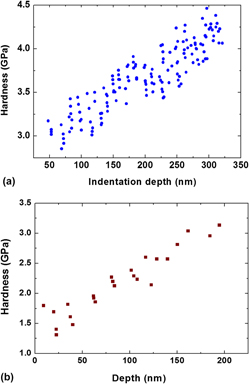Crossref Citations
This article has been cited by the following publications. This list is generated based on data provided by
Crossref.
Amini, Abbas
Cheng, Chun
Kan, Qianhua
Naebe, Minoo
and
Song, Haisheng
2013.
Phase Transformation Evolution in NiTi Shape Memory Alloy under Cyclic Nanoindentation Loadings at Dissimilar Rates.
Scientific Reports,
Vol. 3,
Issue. 1,
Pan, Guanjun
Cao, Zhenhua
Shi, Jun
Wei, Mingzhen
Xu, Lijun
and
Meng, Xiangkang
2014.
Different mechanical response of TiNi film induced by the shape of indenter during nanoindentation.
Sensors and Actuators A: Physical,
Vol. 217,
Issue. ,
p.
75.
Wu, W.-P.
Wei, Y.
and
Liu, P.
2015.
Indentation depth-dependence of the hardness of NiTi shape memory alloy and Al single crystal: phase transition versus plasticity.
Materials Research Innovations,
Vol. 19,
Issue. sup5,
p.
S5-37.
Sun, Y.
Zhao, G.
and
Yang, F.
2015.
Effect of electric current on nanoindentation of superelastic NiTi alloy.
Experimental Mechanics,
Vol. 55,
Issue. 8,
p.
1503.
Priyadarshini, B. Geetha
Aich, S.
and
Chakraborty, M.
2016.
Nano-crystalline Ni Ti alloy thin films fabricated using magnetron co-sputtering from elemental targets: Effect of substrate conditions.
Thin Solid Films,
Vol. 616,
Issue. ,
p.
733.
Dhala, Satyabrata
Mishra, Sushil
Tewari, Asim
and
Alankar, Alankar
2019.
Analyses of orientation dependent nanoindentation response of pseudoelastic NiTi alloy using a crystal plasticity model.
Mechanics of Materials,
Vol. 135,
Issue. ,
p.
1.
Goryczka, Tomasz
Zubko, Maciej
Lelątko, Józef
Salwa, Piotr
Wierzchoń, Tadeusz
Wojewoda-Budka, Joanna
and
Janusz-Skuza, Marta
2019.
Structure and Mechanical Properties of Multi-Functional Layer Deposited on Surface of Ni–Ti Shape Memory Alloy.
MATERIALS TRANSACTIONS,
Vol. 60,
Issue. 5,
p.
693.
Esmaeili, Yasaman
Bidram, Elham
Zarrabi, Ali
Amini, Abbas
and
Cheng, Chun
2020.
Graphene oxide and its derivatives as promising In-vitro bio-imaging platforms.
Scientific Reports,
Vol. 10,
Issue. 1,
VELMURUGAN, C.
and
SENTHILKUMAR, V.
2021.
EFFECTS OF PARTICLE SIZE AND SINTERING TEMPERATURE ON SUPERELASTICITY BEHAVIOR OF NiTi SHAPE MEMORY ALLOY USING NANOINDENTATION.
Surface Review and Letters,
Vol. 28,
Issue. 05,
p.
2150024.
Zhang, Mingyang
Yu, Qin
Wang, Huamiao
Zhang, Jian
Wang, Faheng
Zhang, Yining
Xu, Dake
Liu, Zengqian
Zhang, Zhefeng
and
Ritchie, Robert O.
2022.
Phase-transforming Ag-NiTi 3-D interpenetrating-phase composite with high recoverable strain, strength and electrical conductivity.
Applied Materials Today,
Vol. 29,
Issue. ,
p.
101639.
Rezaee-Hajidehi, Mohsen
Tůma, Karel
and
Stupkiewicz, Stanisław
2023.
Indentation-induced martensitic transformation in SMAs: Insights from phase-field simulations.
International Journal of Mechanical Sciences,
Vol. 245,
Issue. ,
p.
108100.
Lu, Junfeng
Deng, Jingjing
Wei, Yan
Yang, Xiuyi
Zhao, Hewei
Zhao, Qihan
Liu, Shaojia
Li, Fengshi
Li, Yangbei
Deng, Xuliang
Jiang, Lei
and
Guo, Lin
2024.
Hierarchically mimicking outer tooth enamel for restorative mechanical compatibility.
Nature Communications,
Vol. 15,
Issue. 1,
Chen, Ximing
Wang, Bing
Ying, Penghua
and
Zhang, Jin
2024.
Indentation Depth‐Dependent Hardness of Metal‐Organic Framework Crystals: The Effect of Local Amorphization Induced by Indentation.
ChemPhysChem,
Vol. 25,
Issue. 1,
Ben Fraj, Boutheina
and
Zghal, Slim
2025.
Correlation between Hardness Behavior, Shape Memory, and Superelasticity in Ni-Rich NiTi Shape Memory Alloy.
Journal of Materials Engineering and Performance,
Vol. 34,
Issue. 4,
p.
3477.
